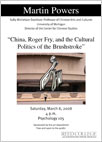Stephen E. Ostrow Distinguished Visitors
Professor Martin Powers, the Sally Michelson Davidson Professor of Chinese Art and Visual Cultures, The University of Michigan
"China, Roger Fry, and the Cultural Politics of the Brushstroke"
March 8, 2008, 4 p.m., Psychology 105
 The term "modernism" in art is often conflated with "Western": modernism IS "Western" modernism. Either term calls to mind the 19 th century rejection of European Classicism. No longer hindered by Classical rules of illusionism and finish (as the story goes), modern artists were free to pursue personal expression by manipulating the formal and material properties of paint, especially color and expressive line. The chief architect of modernist theory in the 20 th century was Roger Fry, but Fry, a socialist, designed his theory to be global. His goal was to replace parochial European theories of ideal beauty with an aesthetic system at once modern and universal. Since Fry's modernism advocated the rejection of post-Renaissance artistic values, he didn't conceive modernism as especially "Western." Indeed, he advocated the abandonment of all "that cumbrous machinery of merely curious representation" which modernist critics associated with the western tradition at that time As an alternative Fry promoted a variety of Asian theories and practices, such as the calligraphic line and the gestural brush stroke. Yet today, formalism and its artistic values are universally accepted as an embodiment of modern, "Western" values. How did Euramerican historians manage to cleanse Fry's hybrid theories of all ethnic impurities? This paper will survey the cultural politics of modernism to better understand how self-referential artistic practices developed across Eurasia came to be configured as emblematic of "the West.
The term "modernism" in art is often conflated with "Western": modernism IS "Western" modernism. Either term calls to mind the 19 th century rejection of European Classicism. No longer hindered by Classical rules of illusionism and finish (as the story goes), modern artists were free to pursue personal expression by manipulating the formal and material properties of paint, especially color and expressive line. The chief architect of modernist theory in the 20 th century was Roger Fry, but Fry, a socialist, designed his theory to be global. His goal was to replace parochial European theories of ideal beauty with an aesthetic system at once modern and universal. Since Fry's modernism advocated the rejection of post-Renaissance artistic values, he didn't conceive modernism as especially "Western." Indeed, he advocated the abandonment of all "that cumbrous machinery of merely curious representation" which modernist critics associated with the western tradition at that time As an alternative Fry promoted a variety of Asian theories and practices, such as the calligraphic line and the gestural brush stroke. Yet today, formalism and its artistic values are universally accepted as an embodiment of modern, "Western" values. How did Euramerican historians manage to cleanse Fry's hybrid theories of all ethnic impurities? This paper will survey the cultural politics of modernism to better understand how self-referential artistic practices developed across Eurasia came to be configured as emblematic of "the West.